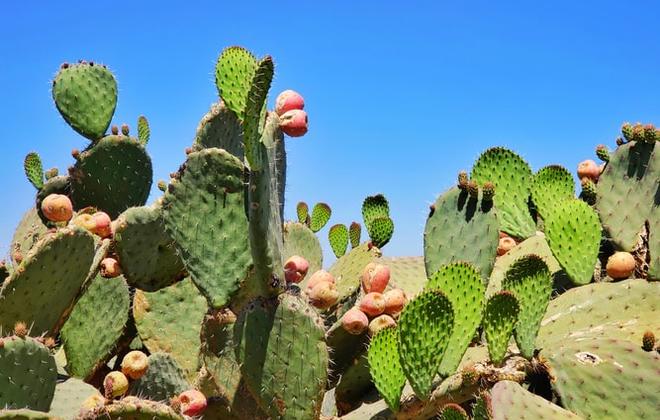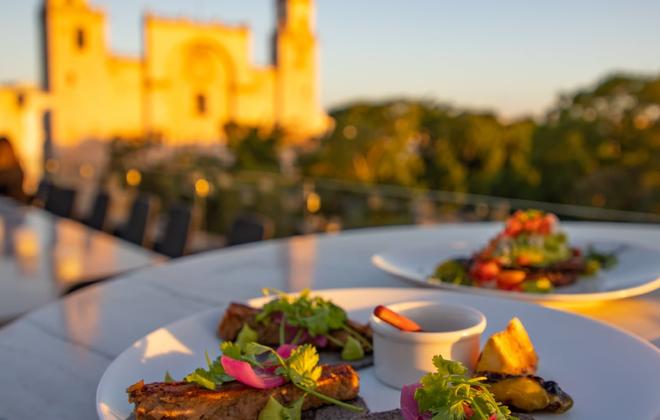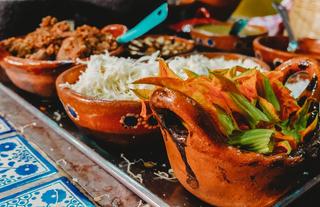Mexico offers travellers a tantalising smorgasbord of nature, history, cuisine and culture. Aztec and Mayan archaeological treasures, tequila, charming colonial cities, Mexican food and beach culture, all these features and more make up this tourist and historical hub. The culturally curious will be bowled over by the impressive sites of ancient civilisations that moulded Mexico’s great pre-colonial history. Nature lovers will be in their element on the pristine beaches that stretch along its 10 000 kilometre coastline or exploring the country’s rainforests, mountain peaks and mangrove lagoons. Gourmands gorge on the distinctive and flavourful cuisine that has become famous worldwide.
Mexico City, one of the largest metropolitan areas in the world, sprawls across the Valley of Mexico. Originally the Aztec city of Tenochtitlan, the city was constructed over the ancient Lake Texcoco. The arrival of the Spanish saw the demolishment of most structures. However, some centuries-old canals and ruins can still be found. Head to the historic centre to see a host of architectural and cultural attractions, including the Plaza de la Constitucion, the National Palace, the Metropolitan Cathedral, the Templo Mayor, the Palace of Fine Arts and the scenic Central Alameda Park. Top attractions such as Chapultepec Castle, the Modern Art Museum and the National Museum of Anthropology can be found in Chapultepec Park.





Dubbed a microcosm of Mexico's best, Oaxaca is a southern state known for its diverse natural landscapes, exquisite architecture, spirited culture, and mouthwatering cuisine. Mountain peaks, canyons, pristine beaches and tropical rainforests have shaped its topography, creating a fertile platform for rich biodiversity – the state is endowed with 50% of all Mexico's plant and animal species. Oaxaca City offers a rich colonial charm and is located only nine kilometres from Monte Albán, a Maya city founded in 500BC, dotted with several hundred artificial terraces. Holidaymakers flock to Oaxaca's pacific coast for its excellent surf, the string of vibrant holiday resort towns, and stretches of pristine coastline where sea turtles come to nest.





Known by many as the cultural capital of Chiapas, San Cristobal de las Casas is an old Spanish colonial town set in Mexico’s Central Highlands. Divided into barrios that are home to specific trades or customs, the colonial grid layout allows tourists to easily explore these neighbourhoods on foot to discover the old architecture, craft markets, and rich cultures of the different areas. San Cristobal de las Casas also lies in the centre of the country’s most indigenous regions, and curious visitors can venture into the surroundings to experience traditional Tzotzil and Tzeltal villages.





Considered one of the best-preserved examples of Mayan architecture, the ruins of Palenque can be found in the dense jungle of Mexico’s Chiapas state. The city flourished between 500 and 700 AD, after which it disappeared into the rainforest until its rediscovery in 1746. Spread over 15 square kilometres, the area is home to hundreds of enthralling temples and palaces that were constructed without the help of metal tools, wheels, or animals. Adorning the structures are relief carvings illustrating Mayan mythology, and the site is dotted with sacred ceiba trees which the Mayans believed to connect the underworld, the earth, and the heavens.





Often overlooked by travellers to the Yucatan peninsula, quiet Campeche offers a plethora of hidden treasures. Pristine, deserted beaches stretch across the coastline; the Tereminos Lagoon offers protection to an abundance of bird and sea life and a day can be spent cruising its mangrove inlets; and the capital of the state is an elegant colonial city. The fortified old town, now a World Heritage Site, was founded in 1540 by Spanish conquistadores. Bright traditional homes of Andalucían and Caribbean influence line narrow cobbled lanes. Just outside town you’ll find Edzna, an ancient Mayan city, and further afield, the Mayan settlements of Calakmul, Uxul and Xicalango.





Merida, the capital of Mexico's Yucatan Province, is situated near the Gulf of Mexico and the captivating Pueblos Mágicos (magic towns). Due to its isolated geographic location, the capital of Yucatan has fostered a unique cultural and political identity. Merida was built on the site of the ancient Maya city T’ho, but many of the existing Mayan pyramids were knocked down by the Spanish to build the large colonial buildings you see today. The city is the second-largest historic centre in Mexico, after Mexico City itself, and has a host of trendy museums, art galleries, restaurants and boutiques. Don’t miss a visit to the famous avenue Paseo de Montejo to view the beautiful sculptures which line the road. The sculpture installation changes every year.





The jewel of Mexico’s beach resort destinations, world-famous Cancun is set on a small sliver of island real estate in the northeast corner of the Yucatan Peninsula. The development of the famed beach resort town started in the 70s, when the Mexican government built a causeway connecting the island to the mainland. Each year thousands of travellers visit Cancun to enjoy its clubbing, beach parties and bikini contests. Culture seekers should head to the various Mayan ruins in the region, such as the ancient settlements of El Meco and El Rey, and Yamil Lu’um, a Mayan temple dating back to the 14th century. The other-worldly Underwater Museum is another must-see, and other exquisite dive sites beckon too. Nature lovers will delight in the chance to spot whale sharks, manta rays and turtles offshore, and explore gorgeous botanical gardens on dry land.








